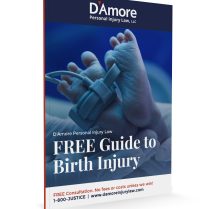Cephalopelvic Disproportion
Our birth injury lawyers will fight to win your child’s case.
CPD Overview
Sometimes, a baby grows so fast before birth that it cannot naturally fit through the mother’s pelvis in delivery. The baby’s head or body can be too large, the woman’s pelvis too small, or the baby positioned incorrectly to fit through the pelvic opening at birth. This condition is called cephalopelvic disproportion.
What is Cephalopelvic Disproportion?
True cephalopelvic disproportion, or CPD, is a relatively rare condition medically, but doctors often diagnose it when the mother stops progressing naturally with labor. When the cervix stops dilating (opening wider in preparation for delivery) or the baby does not drop down through the pelvis as anticipated, doctors will look for a cause for the disruption of the natural processes. Usually, when a doctor correctly diagnoses CPD, the best course of action is to proceed with a cesarean section, often called a C-section, which is delivery by surgical means.
There are many reasons why the natural labor and delivery process may be interrupted. Often, a doctor may diagnose the condition as CPD, even though it is due to reasons other than the size of the baby or the pelvis. If the OB/GYN has diagnosed CPD before the onset of labor, they may plan a C-section delivery to avoid complications. In other cases, an emergency C-section may be the best alternative if the natural delivery process is not progressing adequately.

What are some causes of Cephalopelvic Disproportion?
There are many reasons why the size relationship between an unborn child and the mother’s pelvis is not well-matched. Some reasons for CPD include:
- Postmaturity, where the due date has passed, but labor has not started naturally
- Abnormal fetal positioning
- A large child due to genetic or other factors
- A small pelvis or unusual shape to the pelvis
Doctors might note an especially large fetus in proportion to the mother’s body size and pelvis before the start of labor, in which case they might anticipate that CPD could be an issue. In that case, they may plan a C-section birth ahead of time. In many other cases, cephalopelvic disproportion is not diagnosed until labor has begun and doesn’t progress as anticipated.
The natural delivery process involves the baby’s head molding to fit through the pelvis and the joints of the pelvis spreading to allow more room for passage. Doctors may administer oxytocin, a medication that helps to encourage labor contractions, or they may determine that the CPD condition won’t allow for vaginal delivery and order a C-section at that time.
What happens in cases of Cephalopelvic Disproportion?
If properly diagnosed and treated, CPD can be safely managed by the doctor closely monitoring the baby’s position before delivery and sometimes helping the process along with drugs like oxytocin to stimulate labor. If the process stalls without signs that it can continue normally, an emergency C-section can avoid complications and risks to the health of the mother and child.
If not properly diagnosed and handled appropriately, though, CPD can lead to complications that can be serious. The baby may suffer from a lack of oxygen during birth, which can lead to birth injuries. One is cerebral palsy, which affects the child’s muscle control and physical functioning.
Learn more about what to do after a Birth Injury in our FREE guide.
RELATED ARTICLES

Long-term effects of Shoulder Dystocia

Cerebral Palsy
FREE Case Consultation
Fill out the form below and we will contact you.
[grow-contact-form]
Or, give us a call at
